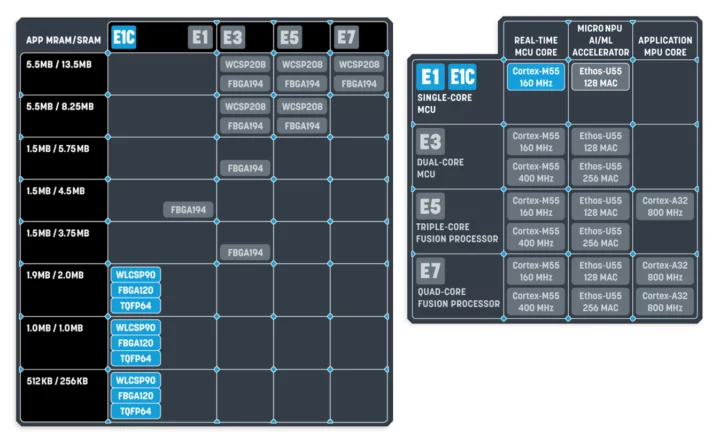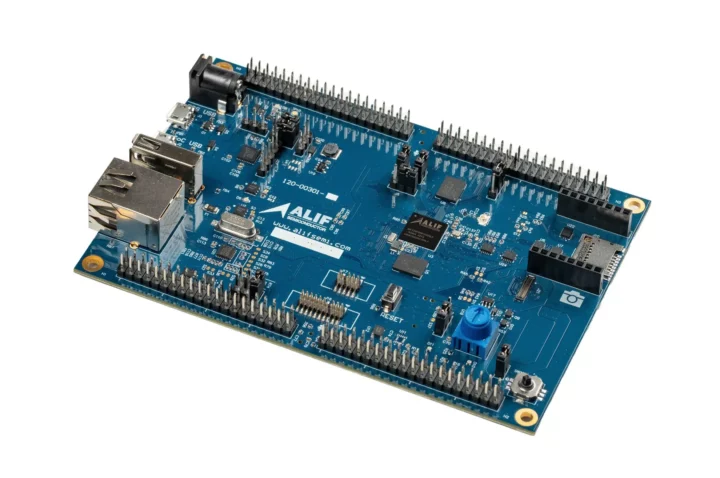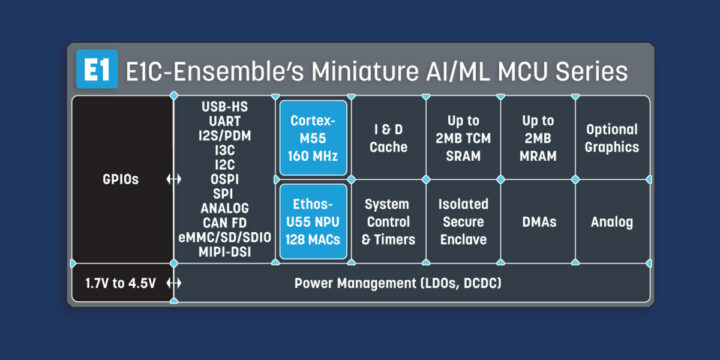Alif Semi Ensemble E1C is an entry-level addition to the company’s Ensemble Cortex-A32M35 processors and microcontrollers with Ethos-U55 microNPUs that targets the very edge with a 160 MHz Cortex-M55 microcontroller and a 46 GOPS Ethos-U55 NPU.
The Ensemble E1C is virtually the same as the E1 microcontroller but with less memory (2MB SRAM) and storage (up to 1.9MB non-volatile MRAM), and offered in more compact packages with 64, 90, or 120 pins as small as 3.9 x 3.9mm.
Alif Semi Ensemble E1C specifications:
- CPU – Arm Cortex-M55 core up to 160 MHz with Helium Vector Processing Extension, 16KB Instruction and Data caches, Armv8.1-M ISA with Arm TrustZone; 4.37 CoreMark/MHz
- GPU – Optional D/AVE 2D Graphics Processing Unit
- MicroNPU – 1x Arm Ethos-U55 Neural Processing Unit with 128 MAC; up to 46 GOPS
- On-chip application memory
- Up to 1.9 MB MRAM Non-Volatile Memory
- Up to 2MB Zero Wait-State SRAM with optional retention in increments of 64KB (450 nA), 128KB (900 μA), 256KB (1.8 μA), 512KB (3.6μA), 1MB (7.2 μA), 2MB (14.4 μA) at 3.3V
- External memory interfaces
- 1x Octal SPI up to 80 MB/s SDR, 160MB/s DDR with Inline AES Decryption, XIP Mode Support, HyperBus Protocol Support
- 1x SD v4.2, eMMC v5.1
- Display interfaces
- 1-lane MIPI DSI
- 1x Display Parallel Interface (DPI) up to 24-bit RGB
- Camera interface – Low-Power Camera Parallel Interface (LPCPI), up to 8 bits
- Audio Interfaces
- 2x I2S Synchronous Stereo Audio interfaces
- Low-Power I2S Stereo Audio Interface
- 4× 2-channel Low-Power Pulse Density Modulation (LPPDM) for microphone inputs (up to 8x Mono Microphones)
- General Input/Output
- Up to 71x 1.8V GPIOs (shared with peripherals)
- Up to 6x selectable 1.8V to 3.3V GPIOs (shared with peripherals)
- Communication interfaces
- 1x USB 2.0 HS/FS Host/Device with DMA
- 1x SDIO v4.1 channel with DMA
- 2x CAN FD Channel up to 10 Mbps
- 1x MIPI I3C
- 2x I2C up to 3.4 Mbps, 1x low-power I2C
- 6x UART up to 2.5 Mbps (2x with RS485 driver control), 1x low-power UART
- 3x SPI up to 50 Mbps, 1x low-power SPI
- Analog interfaces
- 2x 12-bit ADCs, 1x 24-bit ADC with programmable gain from 1x to 128x
- 1x 12-bit DAC
- 2x high-speed analog comparators with (84 Inputs)
- 1x low-power analog comparator
- Internal Temperature Sensor
- Internal Precision Reference Voltage
- Timing control and measurement
- 4x universal high-resolution 32-bit timers, Quadrature Encoder/Decoder (QEC) enabled
- Watchdog Timer
- 2x Low-Power 32-bit timers
- Real-Time Counter
- Clock Generation
- Internal low-frequency (32.7 kHz) and high-frequency (up to 76.8 MHz) RC oscillators
- External low-frequency (32.768 kHz) and high-frequency (24 MHz to 38.4 MHz) crystal oscillators
- 1x User Fractional Mode PLL, 1x Fractional Audio PLL
- Secure Enclave
- Hardware-based Root-of-Trust with Unique Device ID
- Secure Key Generation and Storage, Secure Certificate Storage
- Factory-provisioned Private Keys
- Crypto Accelerators—AES (up to 512), ECC, SHA, RSA, and TRNG
- Secure Debugging with Certificate Authentication
- Secure RTC
- Complete Secure Lifecycle Management
- Misc
- General DMA Controller
- CRC accelerator with programmable polynomials
- Programmable low supply voltage detection warning (Brown-Out Detector)
- Power-On Reset and Brown Out Reset
- Real-Time Clock (RTC)
- JTAG/SWD debug interface
- Power management
- 1.71 V to 4.2 V Primary Supply Range
- Power consumption
- 700 nA at 3.3 V Consumed in STOP Mode with LPRTC Running; 400 µs Wake Time from STOP Mode
- As Low as 22 µA/MHz Dynamic Consumption for High-Efficiency Cortex-M55 at 3.3 V
- Autonomous Intelligent Power Management (aiPM)
- Packages
- FBGA120 – 6.6 x 6.6 mm, 0.5 mm pitch; for maximum I/O while requiring only 4 PCB layers for routing
- WLCSP90 – 3.9 x 3.9 mm, 0.4 mm pitch; for maximum space savings
- TQFP64 – 10 x 10 mm, 0.5 mm pitch; for maximum durability in harsh environments
- Temperature range
- -40°C to 105°C industrial ambient temperature range
- -40°C to 125°C industrial ambient temperature range
- Process – FD-SOI low leakage process

Alif says the Arm Ethos-U55 NPU performs 128 MACs/cycle to give ML output of 46 GOPS resulting in inferencing performance about 100x faster and more power-efficient than competing MCUs based on an Arm Cortex-M4 CPU. Some variants of the E1C devices are offered without the NPU for use cases the Helium Vector extension in the Cortex-M55 delivers sufficient performance for a specific machine learning application.
Alif Semi further adds the Ensemble microcontrollers are compatible with the Arm ecosystem of tools, development environments, and software resources for efficient system development without going into details. The DK-E1 development kit can be used for evaluation, but it’s not available yet. Instead, the DK-E7 development kit can be found on Arrow for $249 and is suitable for software development from the E1 up to the E7.

With low-power consumption and ML capabilities, the Ensembled E1C microcontrollers are especially suitable for battery-power devices running on-device ML workloads such as object recognition, speech recognition, sensor fusion, and adaptive audio noise cancellation without having to rely on the cloud for processing.
The Ensemble E1C Cortex-M55 AI/ML microcontrollers and the related DK-E1 kits will be available to lead customers in August 2024, and mass production is expected to start in Q4 2024. Further details may be found on the product page and in the press release.
Thanks to TLS for the tip.

Jean-Luc started CNX Software in 2010 as a part-time endeavor, before quitting his job as a software engineering manager, and starting to write daily news, and reviews full time later in 2011.
Support CNX Software! Donate via cryptocurrencies, become a Patron on Patreon, or purchase goods on Amazon or Aliexpress






46 GOPS = 0.046 TOPS, right?
So does not really compete with solutions offering >1 let alone 40 TOPS?
Yes, it does compete in terms of power consumption and area. You can’t run a 40 TOPS machine that consumes > 30 Watts on battery very long.